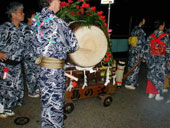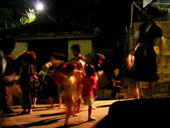In these days, the time when Bon Dancing ends is becoming rather earlier, but even though, the image that Bon Dancing is danced from twilight to night is shared among people.
If that is the case, why do they dance at night in Bon Dancing ? “It is cooler in the night”? No no, not only that. There is a nice reason besides that.
The time of Bon Dancing is “night”
I haven’t seen data searching the time of Bon Dancing, but as far as I see the trend of Bon Dancing around the city, in most cases it starts from twilight and ends around 9:00 at night.*
*Of course, Bon Dancings of school events is often held during the day.
The time of Bon Dancing is at night (Yofuke Eisah)
Why do they dance at “night”?- The time theory of the festival
Why don’t they dance during the day when it is light and befitted for physical exercise, but trouble themselves to dance at night ?
“Because it’s cool” is a sidebar reason. For instance, as we mention later, there are quite a lot of regions in Japan where they consciously preserve the tradition of “Tetsuya Odori (All night dancing)” which they dance all night long.*1 There must be a good reason in why the Japanese insisted in “the night” this much. * Among the places that we visited, Tetsuya Odori (All night dancing) is danced in the following Bon Dancings;
Owara Kaze no Bon
Niino Bon Dancing
Gujo Dancing
Shirotori Dancing
Ryohshi Kanko Dancing
The most important and the most fundamental reason is that the festivals of Japan were something that was originally held at night.*2
We, who live in the modern times, no longer question about the fact that the festivals are held in the daytime. However, if we look carefully, in the festivals held in traditional Shinto shrines, we notice that traditions such as “Yoimiya” and “Yomiya” (the night before the day of the festival) can be observed, and offices that they sit up all night are held.
The belief that “the night” is a holy and mysterious time, and the time when the gods comes down to earth is very natural, and people had this belief from a very old time. The basic structure of the festivals in Japan is that people salute, entertain him warmly, and send off the gods on this night.
And the contents of the ceremony of the festival will be, to serve the meal to the gods who visited, welcome them with various entertainments and wait on them beside them all night long without having a sleep.
*2 In the delightful book, “Nihon no Matsuri (The festivals of Japan)”, Kunio Yanagita thoroughly describes about the essence of the time of the festival.
“Our day of the festival started from Yuhmike, or the border of the day, in other words, if it’s now it will be the day before, and completed in the next Asamike. That is to say, the important part of our festival is from the early-evening to the next morning, and they rendered the service mainly indoors and built bonfires in the garden. (Exerpt from the book written by Kunio Yanagita, published by Kadokawa Bunko)

The example of the festival of Yoimiya (Enoshima Shrine) <2002,07,13 in Fujisawa City>
Obon is a type of festival of “Tama-matsuri”, a festival to salute the spirits that are important for the families and Mura (local villages). Bon Dancing has an aspect that it is an entertainment to welcome and hold a mass for the spirits.*3
We can consider that the people dance even all night long in Bon Dancings, because these traditions of “the festival” from the old times are inherited very well in Bon Dancings. *3 There is a region which says that “When the dancers have fun dancing, the spirits are having fun together” The other names of Bon Dancing, such as, “Mouja Odori (Dance for the dead)”, “Seirei Odori (Dance for the spirits)” may have to do with these aspects.

